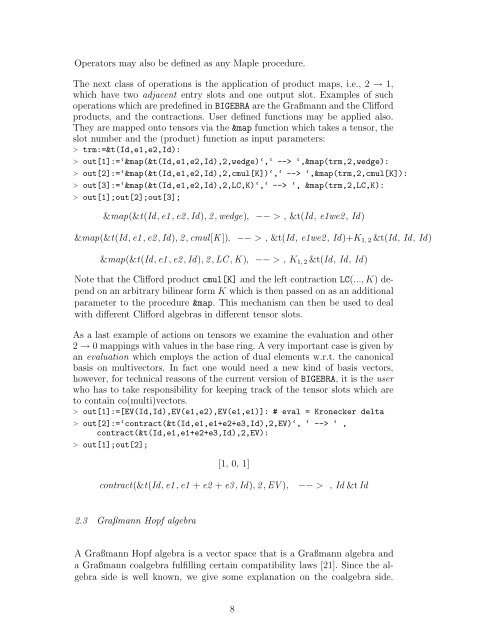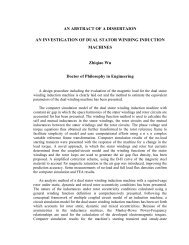CLIFFORD AND GRASSMANN HOPF ALGEBRAS VIA THE ...
CLIFFORD AND GRASSMANN HOPF ALGEBRAS VIA THE ...
CLIFFORD AND GRASSMANN HOPF ALGEBRAS VIA THE ...
Create successful ePaper yourself
Turn your PDF publications into a flip-book with our unique Google optimized e-Paper software.
Operators may also be defined as any Maple procedure.<br />
The next class of operations is the application of product maps, i.e., 2 → 1,<br />
which have two adjacent entry slots and one output slot. Examples of such<br />
operations which are predefined in BIGEBRA are the Graßmann and the Clifford<br />
products, and the contractions. User defined functions may be applied also.<br />
They are mapped onto tensors via the &map function which takes a tensor, the<br />
slot number and the (product) function as input parameters:<br />
> trm:=&t(Id,e1,e2,Id):<br />
> out[1]:=‘&map(&t(Id,e1,e2,Id),2,wedge)‘,‘ --> ‘,&map(trm,2,wedge):<br />
> out[2]:=‘&map(&t(Id,e1,e2,Id),2,cmul[K])‘,‘ --> ‘,&map(trm,2,cmul[K]):<br />
> out[3]:=‘&map(&t(Id,e1,e2,Id),2,LC,K)‘,‘ --> ‘, &map(trm,2,LC,K):<br />
> out[1];out[2];out[3];<br />
&map(&t(Id, e1 , e2 , Id), 2 , wedge), −− >,&t(Id, e1we2 , Id)<br />
&map(&t(Id, e1 , e2 , Id), 2 , cmul[K ]), −− >,&t(Id, e1we2 , Id)+K1, 2 &t(Id, Id, Id)<br />
&map(&t(Id, e1 , e2 , Id), 2 , LC , K ), −− >,K1, 2 &t(Id, Id, Id)<br />
Note that the Clifford product cmul[K] and the left contraction LC(..., K) depend<br />
on an arbitrary bilinear form K which is then passed on as an additional<br />
parameter to the procedure &map. This mechanism can then be used to deal<br />
with different Clifford algebras in different tensor slots.<br />
As a last example of actions on tensors we examine the evaluation and other<br />
2 → 0 mappings with values in the base ring. A very important case is given by<br />
an evaluation which employs the action of dual elements w.r.t. the canonical<br />
basis on multivectors. In fact one would need a new kind of basis vectors,<br />
however, for technical reasons of the current version of BIGEBRA, it is the user<br />
who has to take responsibility for keeping track of the tensor slots which are<br />
to contain co(multi)vectors.<br />
> out[1]:=[EV(Id,Id),EV(e1,e2),EV(e1,e1)]: # eval = Kronecker delta<br />
> out[2]:=‘contract(&t(Id,e1,e1+e2+e3,Id),2,EV)‘, ‘ --> ‘ ,<br />
contract(&t(Id,e1,e1+e2+e3,Id),2,EV):<br />
> out[1];out[2];<br />
[1, 0, 1]<br />
contract(&t(Id, e1 , e1 + e2 + e3 , Id), 2 , EV ), −− > , Id &t Id<br />
2.3 Graßmann Hopf algebra<br />
A Graßmann Hopf algebra is a vector space that is a Graßmann algebra and<br />
a Graßmann coalgebra fulfilling certain compatibility laws [21]. Since the algebra<br />
side is well known, we give some explanation on the coalgebra side.<br />
8
















